2
2.1 THE DISASTER
In 1900 Spain had around 18.5 million inhabitants and the average life expectancy was only 35 years, below the European average. Most people were illiterate and very poor. King Alfonso XIII, the current king’s great grandfather, reigned in a very turbulent Spain from 1902 to 1931.
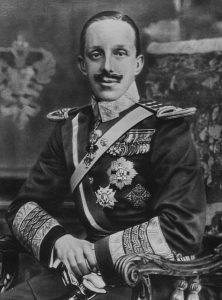
Spanish society was deeply divided between classes that had completely different interests and were bound to clash. On the one hand, military officers, Catholic Church hierarchy, landowners, small farmers and middle-class urban classes were more likely to support the monarchy and vote for centre to right-wing political parties. On the other hand, industrial workers, landless peasants and intellectual urban classes would favour liberal and Marxist parties and even join Anarchist trade unions. At that time elections were systematically rigged. Only men had the right to vote. The two main political sides (conservatives and liberals) had put in place an arrangement that allowed them to alternate in government. This only led to corruption and inefficiency. Anarchist attacks were frequent. Two PMs were assassinated by Anarchists. Workers were starting to unionise themselves and organize strikes to demand better working conditions. Nationalist politicians in the Basque Country and Catalonia were also making demands for linguistic rights and devolution of powers.
In 1898, just before Alfonso became king, the Spanish navy had been badly defeated by the US navy in a war involving the last important colonies left to the once powerful Spanish empire. Cuba, Puerto Rico, and the Philippines had rebelled against their metropolis and the USA had come to their support hoping to get hold of these territories, which they did. The humiliating defeat revealed the economic, social and military weakness in the country. It is known as el Desastre (the ‘Disaster’). Spanish intellectuals of the time wrote in favour of a ‘regeneration’ of the country.
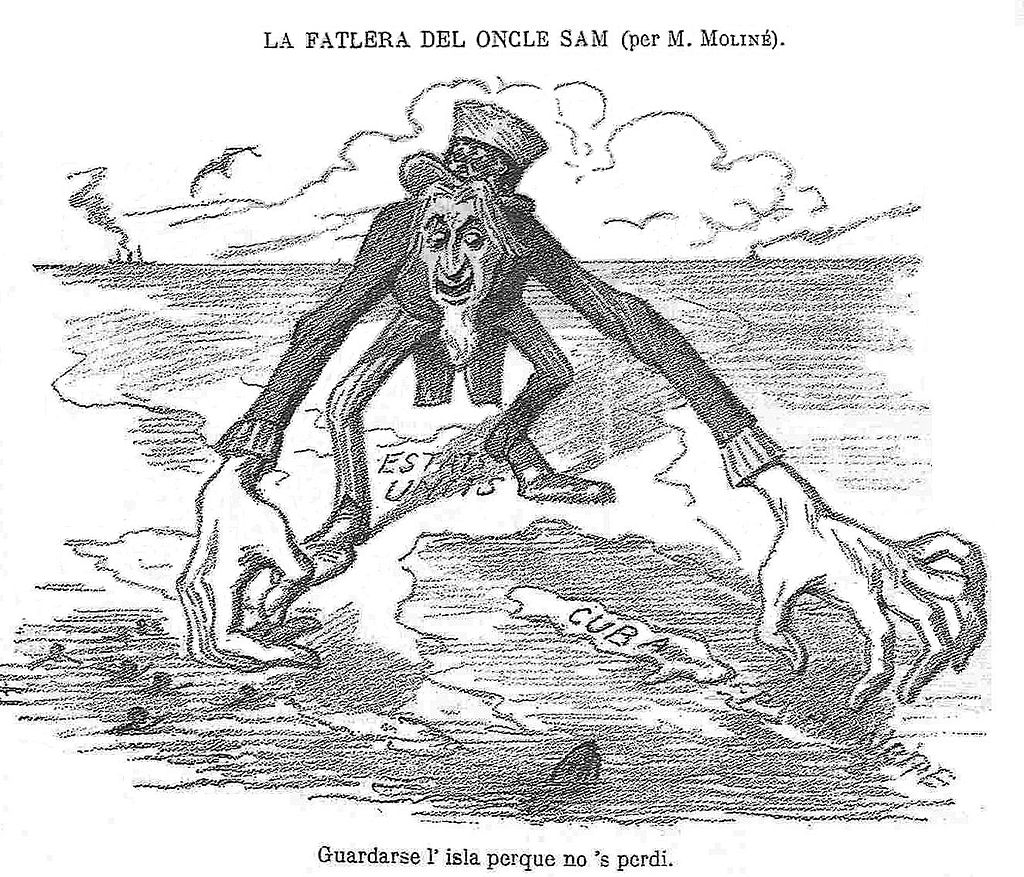
Spain was also having problems both with native rebellions in its protectorate in Morocco and with the conscription of troops. Conscription was compulsory unless one could afford to pay the required amount of money to avoid it. As a result, it was poor workers and peasants who made up the troops that would fight in miserable conditions. In 1909 a whole week of violence took place in Barcelona. Socialists and Republicans had called for a strike to protest about the massacre of Spanish soldiers in a military assault in Morocco. The strike turned violent and some churches and convents were set on fire. These events are known as the Semana Trágica (the ‘Tragic Week’). They were harshly dealt with by the army and the government. A bigger massacre in Morocco was to come. In 1921 4,000 Rif native rebels killed 15,000 Spanish soldiers in the battle of Annual. This disaster was mainly due to incompetency on the part of the military officers within the Spanish Army of Africa, but the king was also bitterly criticized.
In order to avoid a further destabilization of the regime, General Miguel Primo de Rivera took over the reins of the country in a coup in 1923, with the king’s blessing. Primo de Rivera installed a ‘soft’ dictatorship until 1930 in a country which was becoming politically more and more torn between left and right-wing extremes. The dictatorship was very harsh towards those who attacked the government, the Church or the military. Strict press censorship was implemented. Communism, anarchism and, especially, Basque and Catalan nationalisms were severely repressed. One of the greatest philosophers and novelists of the time, and also Vice-president of the University of Salamanca, Miguel de Unamuno, was exiled to the Canary Islands, for his criticism of the regime.
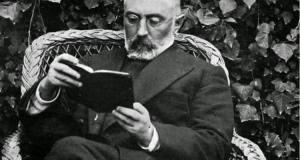
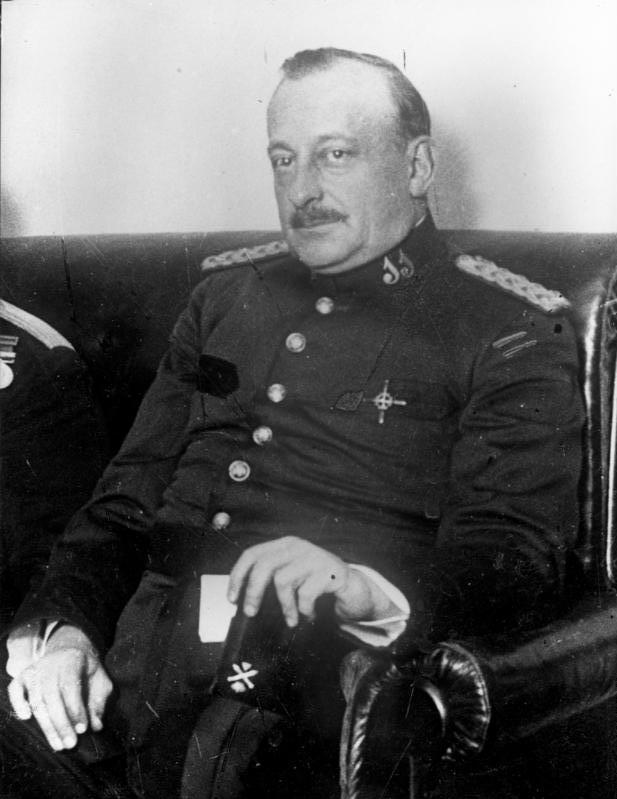
The rebellions in Morocco were finally suppressed in 1926. No cruelty was spared in these wars. Mustard gas was used against the rebels. Appalling acts of torture and mutilation were performed on enemy bodies on both sides. These wars were the training ground for military officers, one of them the future dictator Francisco Franco. Some of these cruel war tactics used in Morocco would be deployed against the Republicans later in the Civil War.
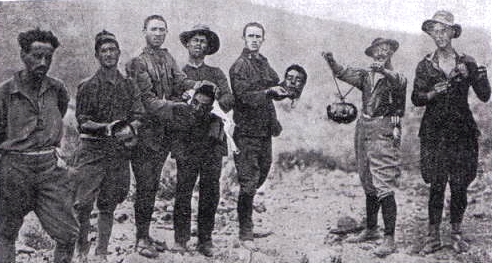
Despite some advances in trying to implement order in the country and some social reforms, conflicts flared up again and, in the end, the king turned against Primo de Rivera, who resigned and exiled himself in Paris in 1930.
In the 1931 local elections, the Republican parties won in most big cities. This result was interpreted as a clear rejection of the monarchy, and the king fled the country. The Second Republic was proclaimed on April 14th 1931.
THE FIRST REPUBLIC
The reason why this period is called the Second Republic is because a short-lived republic had been proclaimed previously in the 19th century. The First Republic was a chaotic political period in Spain between the abdication of Amadeo I and the coronation of Alfonso XII that expanded from February 1873 to December 1874.
EL DESASTRE
Alfonso XII, bisabuelo del actual rey, reinó en un periodo muy turbulento y tuvo que abandonar España en 1931. La sociedad española estaba muy dividida entre grupos con intereses políticos opuestos. Por una parte, los partidos conservadores y de derecha apoyaban a la monarquía. Sus votantes eran los ricos, la Iglesia y los mandos del ejército. Los obreros industriales, jornaleros sin tierra y los intelectuales preferían los partidos progresistas y de izquierda. Además, las doctrinas libertarias anarquistas tenían muchos seguidores entre los más pobres. Las elecciones eran fraudulentas y sólo podían votar los hombres. Muchos obreros se afiliaron a sindicatos y empezaron a hacer huelgas para reclamar mejores condiciones laborales. En Cataluña y el País Vasco los movimientos nacionalistas exigían derechos lingüísticos y autonomía.
En 1898 Estados Unidos había derrotado a España y había tomado posesión de Cuba, Puerto Rico y Filipinas. Esta humillación se conoce como ‘el Desastre’ y animó a muchos intelectuales a escribir sobre la necesidad de modernizar España.
En el protectorado español de Marruecos el ejército español tuvo que enfrentarse a los rebeldes rifeños. La mayoría de los soldados en el ejército español eran obreros y jornaleros que no podían pagar la cantidad de dinero necesaria para evitar servir en el Ejército de África, como se conocía. También había tropas moras en el lado español. Las masacres de soldados provocaron protestas violentas en Barcelona en 1909 durante varios días. Se conoce como ‘la Semana Trágica’. La mayor masacre de soldados españoles tuvo lugar en Annual en 1921 debido a la incompetencia de los oficiales.
Para poner orden en el país el rey aceptó el golpe de estado del general Miguel Primo de Rivera que duró de 1923 a 1930. Fue un periodo de censura y represión.
La rebelión en Marruecos fue suprimida en 1926. Las guerras de Marruecos fueron crueles en extremo. El futuro dictador Francisco Franco y otros generales africanistas, es decir, oficiales españoles que lucharon en Marruecos, aprendieron sus tácticas militares en estas guerras y las usaron más tarde durante la Guerra Civil.
A pesar de los intentos del dictador Primo de Rivera, la situación empeoró y perdió la confianza del rey. Tuvo que abandonar España en 1930. En 1931 hubo elecciones municipales. Los partidos republicanos, es decir, antimonárquicos, ganaron en las principales ciudades. El rey abandonó España. El 14 de abril de 1931 se proclamó la Segunda República.
CULTURAL RESOURCES
FILMS
1898, Our Last Men in the Philippines (1898 Los últimos de Filipinas, 2016) (Netflix) Historical drama about the last stand of a few Spanish soldiers to defend a garrison against Filipino revolutionaries.
Morocco, Love in Times of War (Tiempos de guerra, 2017) (Netflix) Series about Spanish Morocco.
Gun City (La sombra de la ley, 2018) (Netflix) Thriller about the strikes and gangsters in Barcelona in the 1920s.
Cable Girls (Las chicas del cable, 2017) (Netflix) Series set in 1920s Madrid.
2.2 THE SECOND REPUBLIC (1931-1936)
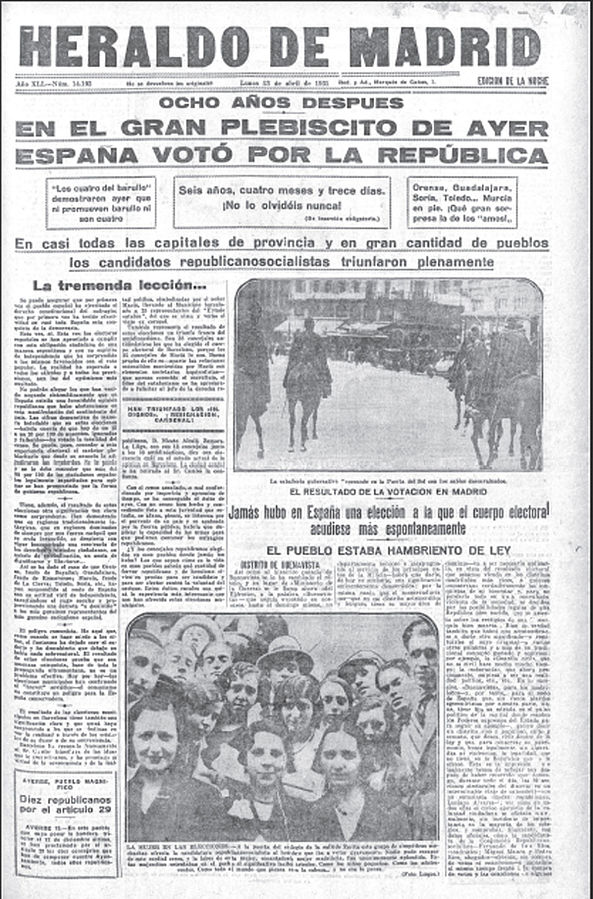
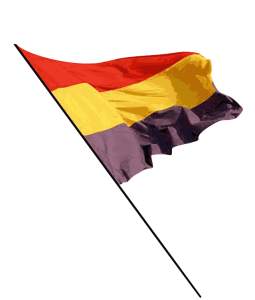
The Republic raised people’s expectations of modernity and social justice. Industrial workers hoped to improve their working conditions and peasants hoped for agrarian reform. The ‘historical regions’ (Basque Country, Catalonia and Galicia) saw this as their opportunity to achieve some form of self-government within Spain. All this was felt as a threat by the elites (industrialists, landowners, the Church, high-ranking military officers). Whether the Republic was to survive or not was a matter of a very fine balance between all these social forces. In the end its enemies proved to be stronger.
In order to understand this period, we can divide it into three phases:
2.2.1 Constitution and reforms (April 1931-November 1933)
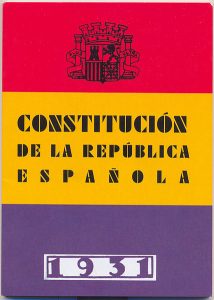
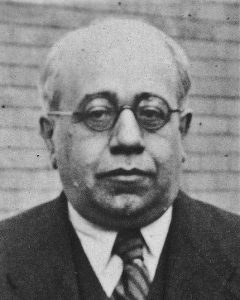
As a result of the 1931 election a Republican-Socialist coalition government set about ruling the country. For the first time there were women in Parliament: Clara Campoamor, Victoria Kent and Margarita Nelken. This government’s first endeavor was to draft a progressive constitution for the new Republic. This Constitution extended universal suffrage to women on equal terms with men. Until then women could run for Parliament but could not vote. Campoamor fought hard to get this provision passed in Parliament, even if, ironically, Kent and Nelken voted against it together with other Republican and Socialist MPs. The reason for this contradictory vote from progressive forces was the fear of an increase in votes in future elections for monarchist and conservative parties due to the Church’s influence on women.
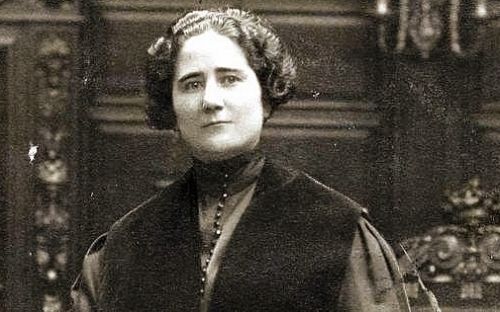
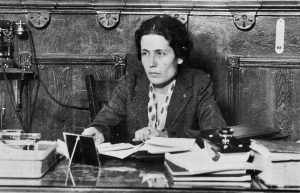
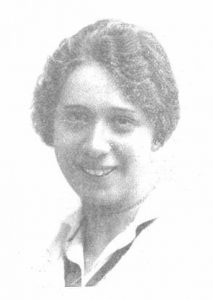
CULTURAL RESOURCES
Clara Campoamor. La mujer olvidada. (RTVE 2011) (TV film in Spanish about one of the first women in the Spanish Parliament set in 1931)
The Constitution also made provision for devolution of power to ‘historical regions’ (Basque Country, Catalonia and Galicia). Its most controversial item was establishing the separation between Church and State, in a country were the Catholic Church had had special privileges for centuries and was the main provider of education. The new government took measures to curtail the Church’s control over education. The Jesuit order was dissolved. A progressive divorce law was passed in Parliament. Prime Minister Manuel Azaña proclaimed that Spain was no longer Catholic. These anticlerical measures were going to ruffle many feathers, not only the Church’s. The conservative, monarchist and right-wing forces in the country saw this as a head-on attack against the essence of ‘Spanishness’ as they understood it.
Workers and peasants were demanding social reforms, as this was the reason why they had voted for left-wing parties. The new labour reform law improved salaries and work conditions. The 8-hour working day was implemented, and, for the first time, workers had a right to paid holidays. The new agrarian reform law aimed at a fair redistribution of the land to improve the appalling conditions in which landless labourers lived and worked in the latifundios. These were large states in the south of Spain owned largely by absentee landlords where peasants worked in conditions not very different to those of serfs in the Middle Ages. This reform did not go far enough since the government lacked the finances to compensate owners for forced expropriations. Wealthy landowners, typically conservative monarchists, saw their worst fears realised under this progressive republican government. At the same time, agricultural labourers were disheartened at the slowness of the process. The most radical embarked on protests. In 1933 in Casas Viejas, a small village in Andalusia, Anarchist peasants stormed the Guardia Civil barracks. The repression against the protesters was brutal. There is no agreement regarding the number of deaths, figures between 12 and 24 are given by different historians. This cruel incident led to the loss of support for the coalition government by its left-wing allies, more sympathetic to the peasants’ cause. Also, the right-wing parties in the opposition took advantage of this event to undermine the government.
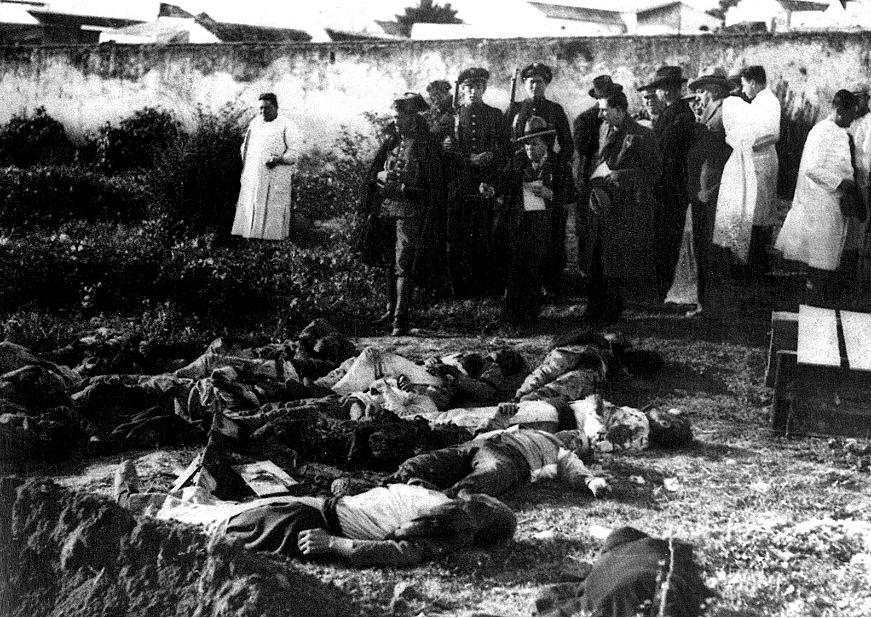
The new government supported devolution of power to the ‘historical’ regions as one of the means to avoid secessionism. This had been the case in Catalonia where, the same day the Second Republic was proclaimed, an independent Catalan Republic within an Iberian Federation had also been proclaimed. Catalonia finally settled for a Statute of Autonomy in 1932.
The government were aware of the threats the Republic was facing. Some of its enemies were high-ranking officers in the armed forces; therefore, they took steps to force their early retirement. This measure did not prevent a right-wing coup attempt by General Sanjurjo in 1932, which failed miserably.
After two years of vertiginous reforms and some unwise decisions, the coalition in government collapsed at the end of 1933 and a new election was called.
La declaración de la República trajo expectativas de reformas sociales y modernización del país. Podemos dividir este periodo en tres fases. La primera fase empieza con las elecciones generales de 1931. Una coalición de partidos republicanos y socialistas ganó las elecciones y formó gobierno con Manuel Azaña como presidente del Gobierno. Por primera vez en España había mujeres en las Cortes (el parlamento español): Clara Campoamor, Victoria Kent y Margarita Nelken.
La Constitución de 1931 daba a las mujeres el derecho a votar por primera vez. Hasta entonces las mujeres podían ser elegidas como diputadas en las Cortes, pero no podían votar. La Constitución también contemplaba la concesión de autonomía para las nacionalidades históricas (Cataluña, Euskadi y Galicia). Además, declaraba España un estado laico con la separación entre Iglesia y Estado.
Las primeras reformas llegaron inmediatamente. Se redujo el control de la Iglesia sobre la educación y se disolvió la Compañía de Jesús (los jesuitas). Se aprobó una ley del divorcio progresista. La reforma laboral mejoró los salarios de los trabajadores, redujo la jornada laboral a 8 horas e introdujo las vacaciones pagadas. También se aprobó una ley de reforma agraria para redistribuir los latifundios entre los jornaleros sin tierra. Esta medida no tuvo éxito por falta de dinero para expropiar a los latifundistas. Algunos campesinos empezaron a protestar por la lentitud de la reforma. El incidente más grave ocurrió en el pueblo andaluz de Casas Viejas en 1933, en el que la Guardia Civil y la Guardia de Asalto mataron a varios campesinos (entre 12 y 24). Este incidente llevó a los partidos de izquierda del gobierno de coalición a retirar su apoyo. Los partidos de derechas en la oposición aprovecharon esta oportunidad para atacar duramente al gobierno.
En 1932 Cataluña consiguió su Estatuto de Autonomía, que le permitía tener su propio gobierno y un número limitado de competencias.
Algunos altos mandos de las Fuerzas Armadas no estaban de acuerdo con el nuevo gobierno. Varios de ellos fueron forzados a jubilarse anticipadamente. Sin embargo, el general Sanjurjo intentó dar un golpe de estado que fracasó.
A finales de 1933, con un gobierno de coalición totalmente desgastado, se convocaron nuevas elecciones generales.
2.2.2 Two Tragic Years (November 1933-February 1936)
Elections were held at the end of 1933. The lack of union between the different Republican parties made it easier for the CEDA (Confederación Española de Derechas Autónomas), a confederation of Catholic right-wing parties, to win the election. The members of the CEDA, a proto-fascist party, did not accept the legitimacy of the Republic, but seized the opportunity to reach power by taking part in the democratic game. This new government focused its efforts in undoing most of what the previous government had implemented. Agrarian reform stopped. The Catalan Statute was abolished. There was a purge of army officers sympathetic to the Republic.
In 1934 a general strike against the right-wing government was convened in several cities. In Catalonia the Catalan government proclaimed a Catalan state within the Spanish Republic. The army entered the Catalan government headquarters and put an end to this insurrection. Over 40 people died in the confrontations with the army. However, the most serious incident is known as the October Revolution in Asturias, from October 5th to October 18th. This was not a rebellion, but a budding revolution. The coal miners, well-organized through their unions and left-wing parties, had got hold of guns and dynamite. They attacked official and religious buildings and managed to occupy several villages and cities in Asturias, implementing the rule of revolutionary committees. 34 priests were murdered in an anticlerical frenzy. Around 250 members of the security forces lost their lives. The government put General Franco, the future dictator, in charge of the eradication of the insurrection. He resorted to the Legion and the Moroccan troops. The repression against the revolutionaries was merciless. Between 1,000 and 1,700 miners lost their lives, thousands were imprisoned and many suffered terrible tortures at the hands of the security forces. Some historians consider this was the last time in history that workers staged a revolution in Europe. The weakness of the government was reflected in the number of reshuffles that took place in a very short period. In the end, two different corruption cases were made public and the president of the Republic dissolved the Parliament and called for an election. This was the end of the ‘Bienio negro’ (‘Two Black Years’).
Las elecciones generales de noviembre de 1933 dieron la victoria a la coalición protofascista de partidos católicos de derechas CEDA. Al llegar al poder pusieron fin a la reforma agraria y abolieron el Estatuto de Autonomía en Cataluña. También llevaron a cabo una purga de oficiales de las Fuerzas Armadas afines a la República.
En 1934 se convocó una huelga general en varias ciudades de España para protestar contra el nuevo gobierno de derechas. El gobierno catalán (la Generalitat) proclamó el estado catalán dentro de la República española, pero el ejército entró en el edificio de la Generalitat y puso fin a la insurrección. Más de 40 personas murieron en las confrontaciones con los militares. Sin embargo, el incidente más grave fue la Revolución de Octubre en Asturias, que duró del 5 al 18 de octubre de 1934. Los mineros se habían organizado y conseguido armas y dinamita. Atacaron edificios oficiales e iglesias y tomaron el poder en algunos pueblos y ciudades a través de comités revolucionarios. 34 sacerdotes fueron asesinados. Unos 250 miembros de las fuerzas de seguridad perdieron la vida en los ataques. El general Franco, futuro dictador, se encargó de organizar el fin de la insurrección. La represión contra los mineros derrotados fue tremenda. Entre 1000 y 7000 trabajadores perdieron la vida. Miles fueron encarcelados y algunos sufrieron terribles torturas.
Al final, dos escándalos de corrupción acabaron con este gobierno de la CEDA y se convocaron elecciones en febrero de 1936.
Two different points of view of the same historical event:
Asturias, Revolución obrera 1934 (Documentary in Spanish)
Asturias Revolution (Contemporaneous news report in English)
2.2.3 The end of the Republic (February-July 1936)
The 1936 election was won by a coalition of Republicans, Socialists and Communists under the name Frente Popular (Popular Front). This was a much more radical left-wing coalition than the one that won in 1931. It was supported by the Anarchist union CNT (Confederación Nacional de Trabajadores). This government restored de Catalan Statute and granted a statute to the Basque Country as well. A new agrarian reform policy, more radical than the previous one, was implemented.
The political polarization was palpable. The right-wing parties and their followers found it impossible to tolerate a new stint of left-wing policies that went against their interests. Many landless labourers and workers saw the new government as the first step towards a full-blown revolution that would change Spain forever. The unrest in some military quarters was easily felt. The new government posted some ‘dangerous’ generals far from centres of government. General Franco was posted to the Canary Islands. All this was to no avail. A small group of generals managed to hatch a plot. On 17th July 1936 the Spanish Army of Africa rose in Morocco and was followed by garrisons in different parts of Spain. The country split in two sections: Republican, loyal to the government, and Nationalist, supporters of the coup. The Spanish Civil War had started.
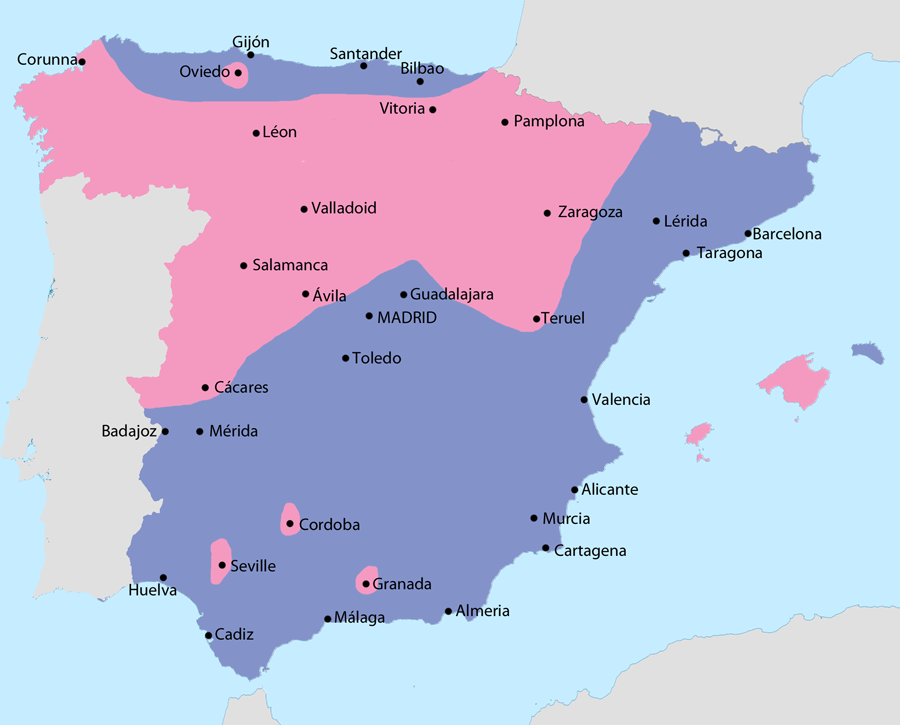
Area under Nationalist control in pink
Area under Republican control in blue
A hundred years before the Civil War the great master Goya painted images that represent symbolically the horror and senselessness of war.
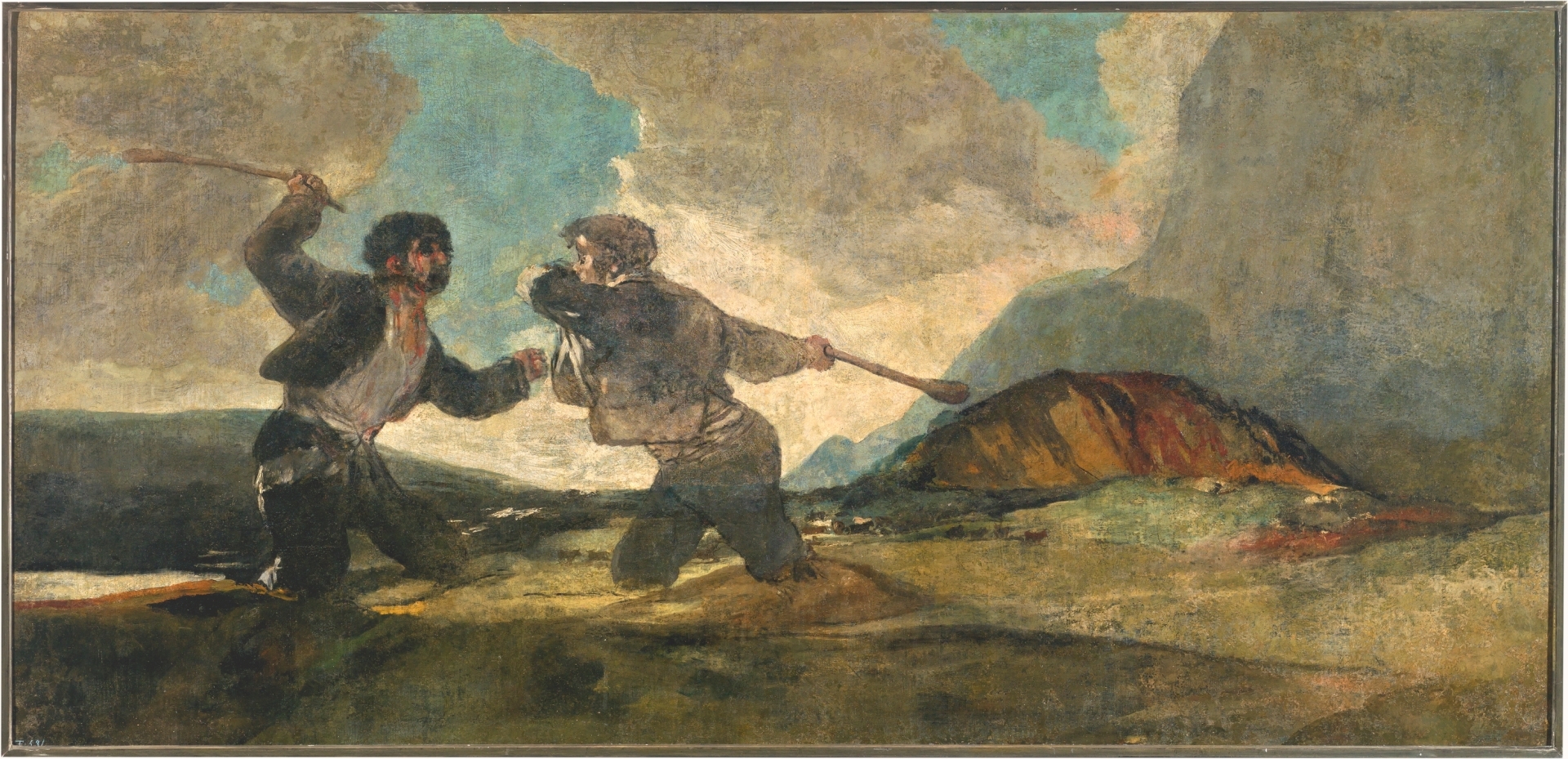

Una coalición de republicanos, socialistas y comunistas ganó las elecciones de febrero de 1936, el Frente Popular. Contaban con el importante apoyo del sindicato anarquista CNT. Se restauró el Estatuto de Autonomía de Cataluña y se aprobó el de Euskadi (País Vasco). Se reanudó una reforma agraria más radical que la anterior.
Pero el país estaba dividido. Los partidos de derechas y sus seguidores no querían seguir tolerando un gobierno de izquierdas. Muchos trabajadores y jornaleros soñaban con una revolución y una sociedad igualitaria. Había rumores de golpe de estado. El gobierno envió a algunos generales antirrepublicanos a destinos lejanos. El general Franco fue enviado a las Islas Canarias. Estas medidas no sirvieron de nada. El 17 de julio de 1936 el Ejército de África se alzó en Marruecos contra el gobierno y varios oficiales se unieron a la sublevación en la Península. España quedó dividida en dos secciones: la republicana, leal al gobierno, y la nacional, en rebelión contra el gobierno. La guerra civil había comenzado.
Media Attributions
- Satirical cartoon in Catalan
- Unamuno
- Primo de Rivera
- Guerre_du_Rif_massacre_1922
- 13_d’abril_portada
- Bandera_republicana_ondeando.svg
- 428px-Cubierta_constitucion1931
- Clara-campoamor-photo
- VictoriaKent1931DGP
- Casas_Viejas
- Map_of_the_Spanish_Civil_War_in_July_1936
- Duelo a garrotazos
